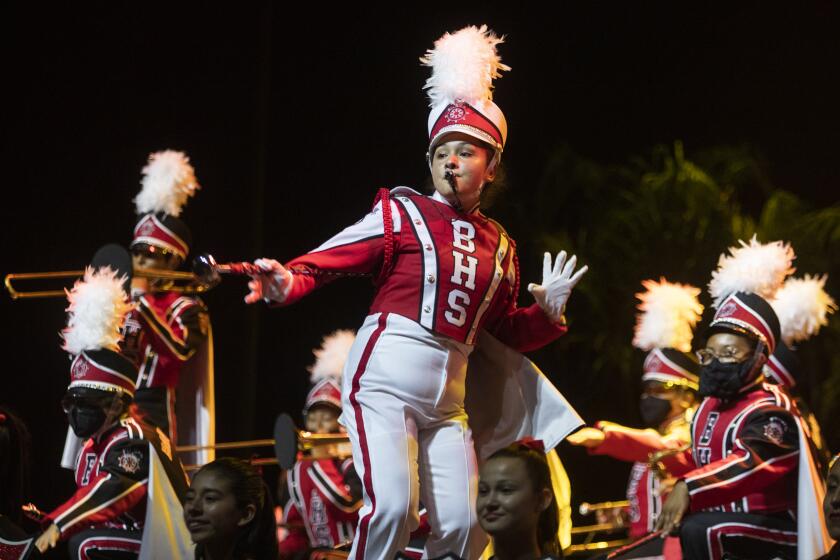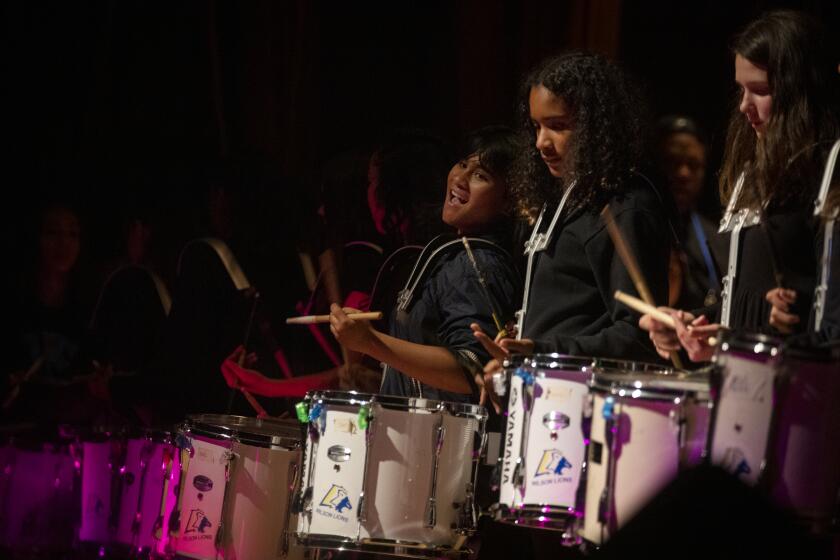LAUSD quietly adds $30 million to arts budget amid allegations it violated the law

- Share via
Los Angeles school officials have quietly added $30 million to elementary school budgets for arts education in the wake of accusations from former Supt. Austin Beutner, parents and union leaders that the district violated Proposition 28, a voter-approved law mandating increased arts funding at all California schools.
The leadership of L.A. Unified, including Supt. Alberto Carvalho, denied any wrongdoing and said the funding shift — included in next school year’s budget — was aimed at avoiding further contention.
The action will restore arts programs paid for by the school district to 2022-23 funding levels, according to officials. This benchmark is crucial because California school systems can’t receive additional arts funding from Proposition 28 unless they maintain their own spending at the 2022-23 levels.
At stake for L.A. Unified is $77 million a year in new funding created by the measure, an amount expected to increase annually.
Voters approved Proposition 28 in November 2022 with a two-thirds majority with the expectation that children would benefit from more arts instruction at every school. Allocations at the state level are determined for every school based on enrollment, with extra dollars added for students from low-income families.
A fundamental promise of the voter initiative was that the new money could be used only to add to arts funding — and not to replace existing funding.
Parents in L.A. Unified became concerned when despite the flow of new dollars, nothing appeared to have changed at their elementary schools. If they had an art teacher on campus two days a week the prior year, that teacher was still on campus two days a week. Some schools even appeared to have had cutbacks, parents reported.
The L.A. school board is scheduled to approve a report on the spending of new arts money Tuesday. Critics say the report skirts legal requirements.
They suspected that the district had swapped in the new state arts money for the district arts funding — leading to little or no gain in arts instruction. Some administrators quietly confirmed such suspicions, to the parents and to The Times.
For months, and including this week, officials have offered various explanations for what happened. They suggested that some schools had expiring arts grants, although they have yet to provide examples. They also talked about declining enrollment, which could have resulted in reductions of services. However, the rate of decline last year was marginal compared with the size of the influx of new state arts dollars.
Officials also said some funding shifts were based on “equity” — providing more to higher-needs students. But no examples have yet been provided.
Deputy Supt. Pedro Salcido said all that matters now is the positive outcome.
“I think the important piece is ... the additional $30 million — that is included in the ‘24-’25 budget,” Salcido said during a presentation at this week’s Board of Education meeting. He talked of a “hold harmless” to affected schools “that we will make whole.”
“So the intent is to kind of do right from the perspective of level setting with the community and how we’re making investments around the arts,” Salcido said. “We want to make sure that as we move forward this is not a place of contention, controversy or questioning.”
Anger remains, however, among critics who include parents who became budget sleuths, Beutner and unions representing the vast majority of employees in the nation’s second-largest school system.
This week the district’s senior leaders acknowledged that $30 million would be needed to restore district-funded arts instruction at elementary schools to the level before Proposition 28 funds arrived.
But officials insisted they were within their legal rights to take money from individual schools provided that total district spending on the arts went up by at least the amount that Proposition 28 provided.
Powerful unions and Proposition 28 author Austin Beutner say school districts are misusing money for expanding K-12 arts education and call for state intervention.
“The accountability test is not done at the school site,” said L.A. schools Supt. Alberto Carvalho, who also spoke during the Tuesday staff presentation. “The accountability test is done districtwide. So is there the possibility of variance in schools? Absolutely. Does that happen? Absolutely.”
Echoing Salcido, Carvalho added:
“We decided, considering the degree of confusion and because ultimately we believe in the benefit of arts education ... to create this additional fund.... Notwithstanding the letter of the law, we decided to lean on the intent, not just the letter, but the intent. How are people perceiving that? And we’re paying a price for that. So ... $30 million is above and beyond full compliance with the letter of the law, leaning more towards what we believe is the understanding of individuals in schools.”
However, Beutner — the author of Proposition 28 — accused the district of making up spending rules that exist nowhere in the law and that explicitly violate its letter and intent.
“District Leadership is violating the law by using Prop. 28 funds to replace existing spending at schools while making false and misleading statements about its implementation,” Beutner and union leaders wrote in an 11-page analysis sent Tuesday to L.A. Unified.
Parents kept digging
Beutner relied substantially on research that parents, including Nicolle Fefferman, who also is a high school social studies teacher, began to conduct.
“Our thinking about arts funding in LAUSD started because a concerned parent began asking questions in our Facebook group in March of 2023,” Fefferman said. “More parents and then teachers began to see problems as well.”
Fefferman has a large network through the Facebook group Parents Supporting Teachers, for which she is an administrator.
“Once a few of us were able to understand how to access that information, we taught others how to do the same,” she said. “We were able to see what had happened — or what did not happen.... We could see the hours of arts instruction at each school did not increase as a result of this new money.”
For months, district officials had insisted that funding reductions at schools were isolated or entailed small amounts of money that were balanced out in other places.
But parents and school staff kept sleuthing and adding more schools to their list.
“The insult is that the school district thinks we are all so stupid we won’t pay attention,” said library aide Franny Parrish, a veteran leader within California School Employees Assn. Chapter 500, whose members include library aides. “They have cheated the children of valuable tools that could help with reading and maybe, just maybe, make them want to stay in school.”
The analysis — signed by Beutner and leaders of unions representing the vast majority of district employees — looked at 14 schools, calling them a small sample of illegal financial abuse.
Going school by school, with incomplete information, the parent sleuths had no firm total for the funding they suspected L.A. Unified pulled from elementary arts programs. But on Tuesday, the district said $30 million would be needed to “make whole” these programs.
This total suggests that once Proposition 28 funds became available, the district largely eliminated its own funding of elementary arts instruction.
L.A. Unified officials said they relied on guidance from the California Department of Education, although they also have said that state guidance has been unclear or slow to develop.
State officials have so far not weighed in on the dispute.
Field trips as arts instruction
District field trips recently became organized under a program called Cultural Arts Passport. Although “arts” is in the name, the program includes field trips of many sorts.
District officials said at the board presentation Tuesday that the Passport field trips were part of total district arts spending of $129.5 million — allowing them to say that overall arts expenditures increased last year.
The public presentation did not reveal how much of the total was spent on the school outings.
A long list of “preferred” field trip locations includes Universal Studios, the “Jeopardy” game show, Disneyland, local recreation centers and indoor skydiving.
Board member Scott Schmerelson questioned why all field trips — such as those to a theme park — qualified as arts education.
Chief Academic Officer Frances Baez partly avoided his question by saying that a trip to a historic mission could be arts-related because students could build on that knowledge to make dioramas: “So it was the follow-up and the deepening of the activity that had that arts connection.”
And, she added, there are arts learning opportunities in every situation and subject matter: “Arts is integrated into math.... It’s integrated into history, language arts. With that integration, people might not understand the direct connection, but it’s integrated.... It’s not a stand-alone. Arts lives everywhere.”
She noted, too, that “the field trips with the highest attendance were the Pantages Theatre.”
Even though a particular field trip could contribute to arts education, under Proposition 28, at least 80% of the new arts funding must pay the salaries of art teachers and up to 20% can be spent on supplies related to that instruction.
In a Thursday email, a district spokesperson said Proposition 28 funds were not used for field trips.
Tuesday’s staff presentation was related to the need for the school board to approve an annual Proposition 28 report that the district is required to send to the state and to post publicly. This report asserts that the district managed its arts funds according to legal requirements and spent more of its own money than ever on the arts.
Board members ultimately raised many of the same concerns that parents and district employees have been raising — and they, too, were less than satisfied with all the answers.
But senior staff warned them that future funds could be jeopardized if they failed to approve the report. The board approved the report with a 5-2 vote.
Schmerelson and board member Rocio Rivas voted no.
More to Read
Sign up for Essential California
The most important California stories and recommendations in your inbox every morning.
You may occasionally receive promotional content from the Los Angeles Times.













